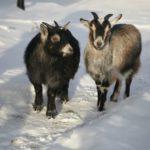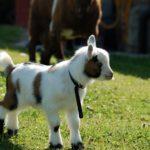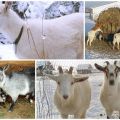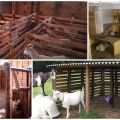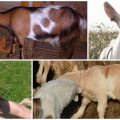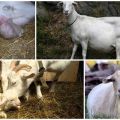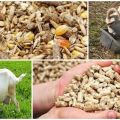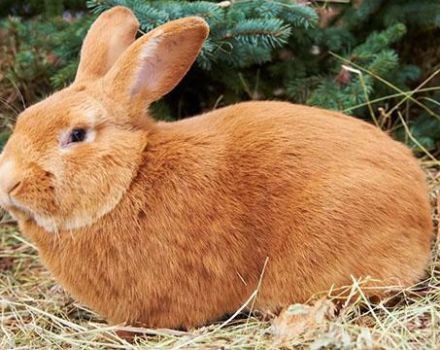The temperature of keeping goats in winter and is it possible to lamb in a cold room
Goats are hardy animals, and keeping them in cold climates is usually not a hassle. If a goat lambes in a cold room in winter, it is recommended to prepare a separate pen for it. It is also important in the sheepfold to create conditions for keeping newborn kids. As a rule, kids born in winter have a stronger immune system. Livestock breeders note that winter newborns grow and gain weight faster.
Features of keeping goats in winter
Usually, sheepfolds are not equipped with special heating, since animals are reliably protected from hypothermia by thick wool. In order to keep sick individuals or females with newborns, several corrals are separated in the sheepfold.
It will be easier to maintain the microclimate in rooms with wooden floors. Or it is advisable to install wooden flooring with a height of 20-30 cm on the concrete surface. The goats are quite clean, so the floor is covered with a layer of straw, which is regularly changed.
It is recommended to keep the room temperature at 6-7 ° C in winter. After lambing, it is desirable to warm up the air to 10-12 ° C. A separate nuance is drinking goats. In the winter season, the water must be heated. During the lambing period, females drink especially a lot. Therefore, it is better to install special heated drinking bowls in the sheepfold.
Can you milk?
It is necessary to distribute goats after lambing gradually, and you should not count on large milk yield in the first week. It is recommended to express milk for the first time about an hour after birth. To increase the amount of milk, a “milk ration” is made up for animals, consisting of hay, vegetables, compound feed and silage. The goats will be easier to milk if the udder is massaged in the early days.
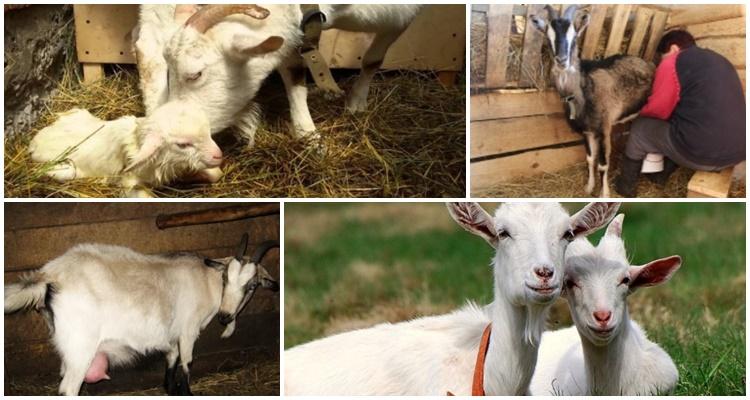
Typically, the peak milk yield is observed 2.5-3 months after lambing. During this period, goats are kept on a high-carbohydrate diet, they are given a lot of water. But you also need to understand that the milkiness of animals depends on the breed. Saanen goats are considered the most dairy.
Subtleties of lambing in winter
Cases of winter lambing are not uncommon. In order for the birth to take place without complications, the premises should be prepared in advance:
- in the sheepfold, the temperature should be 10-12 ° C;
- if there is severe frost outside, it is recommended to equip the room with heating;
- it is advisable to install a wooden flooring with a height of 15-20 cm in the corral. Or, one and a half to two times more straw is placed on the floor;
- water must be warmed up.
Since thermoregulation in newborns is still absent, hypothermia of their bodies must be prevented. It is recommended to put the kids in a box or box covered with a thick layer of straw. In any case, cover the damp kid with a blanket.
What can they get sick with?
Goats have good immunity. By providing the right care for your animals, you don't have to worry about their health. However, the state of health must be monitored constantly. A sick animal most often exhibits the following symptoms:
- shortness of breath;
- breathing becomes rapid;
- lactation stops, udder edema is observed;
- loss of appetite;
- body temperature rises to 41-42 ° C.
Udder inflammation occurs after lambing. Causes of the disease: drafts, dirty damp litter, cold damp floor. For treatment, the affected part of the udder is lubricated with ointments (zinc, lead), warming compresses from camphor oil, ichthyol ointment are applied.
The appearance of cracks on the nipples is provoked by inept milking or poor animal care, rough stabbing bedding. Treatment of teats and udders with boric acid solution helps to eliminate cracks. The damaged areas are also lubricated with ghee, petroleum jelly.

Winter walks
In the cold season, goats are released into the fresh air in good weather and shallow snow. It is recommended to pre-feed the animals with silage or hay. After returning to the stall, the goats are fed a slightly larger portion of feed so that they can calmly rest at night. Winter walks have several advantages:
- the body of the animal is strengthened;
- increased appetite;
- the growth of wool and fluff increases.
The round-the-clock winter keeping of goats in the sheepfold increases the sensitivity of animals to cold and drafts. As a result, the susceptibility to disease increases, appetite decreases and the quality of the coat deteriorates. It should be borne in mind that animals should not be allowed out for a walk in icy conditions, with snow cover above 20-25 cm, strong fogs or strong winds.
Thanks to their thick coat, goats can handle cold winters well. However, you need to be careful with animals during the lambing period. To maintain the productivity of goats and newborns, it is important to provide them with protection from drafts and dampness. But you should not completely isolate the sheepfold, since a safe supply of fresh air will only benefit the animal.


